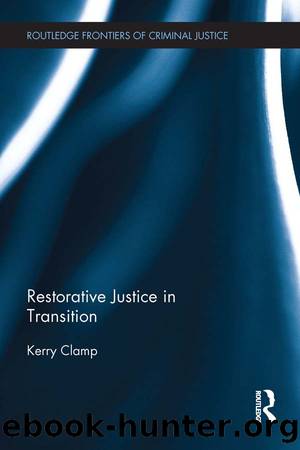Restorative Justice in Transition by Kerry Clamp

Author:Kerry Clamp [Clamp, Kerry]
Language: eng
Format: epub
ISBN: 9781138922365
Barnesnoble:
Publisher: Taylor & Francis
Published: 2015-06-09T00:00:00+00:00
Reconciliation and personalism
Reconciliation is a popular term that is often held out as a principle aim of transitional justice mechanisms (Aiken 2010). Weinstein (2011: 2) points to the religious overtones8 and understandings of reconciliation in the South African TRC as the source that âspawned an industry of reconciliation advocates and practitioners [â¦] that could lead only to inflated expectations and ultimate disappointment on the part of those who sufferedâ. Since then, member states of the United Nations and the European Union have expended considerable amounts of money and human resources on this elusive aim (Clark 2006). However, it is plagued by problems around its conceptual meaning and the âideological use of the âre-conciliationâ discourseâ (Parmentier and Weitekamp 2007: 136). As Chapman eloquently explains:
One reason for the difficulty in understanding the requirements for reconciliation is that the term refers to a wide variety of types and levels of relationships and an equally broad array of initiatives to overcome ruptures in them. Reconciliation is used synonymously with such diverse processes as peace-building, mutual accommodation between former antagonists, reconfiguration of individual and group identities, healing, restorative justice, social repair, and community building.
(2009: 145)
To illustrate this point further, Shriver (2003) shows that reconciliation can be categorised into: national reconciliation (political consensus and interaction); societal reconciliation (which includes both individual and communal reconciliation); personal reconciliation (between victims and offenders); and finally, political reconciliation (between hostile groups). Amstuz (2006) also distinguishes between reconciliation as a process (through which broken relationships are healed) and as a condition (harmonious relationships or co-existence), which are said to speak to outcomes sought by both restorative and transitional mechanisms respectively.
However, the issue with this approach to understanding reconciliation is that the conceptual issue is not a problem around the layers of reconciliation, but rather about what the term actually means. Is it about âsocial cohesionâ (Parmentier and Weitekamp 2007: 135) or âpeaceful co-existenceâ (Chayes and Minow 2003); âforgivenessâ (Shriver 2003) or âtoleranceâ (Van Stokkom 2012); a shared narrative and understanding of the past (Shriver 2003) or reintegration (Eastmond 2010)? Crocker (2002) has attempted to provide some clarification of what we mean by reconciliation by distinguishing between âthickâ and âthinâ notions of reconciliation. âThickâ, âmaximalistâ or âcommunitarianâ notions of reconciliation require victims and broader society to build strong ties with human rights abusers. Here, it is the development of a shared narrative of the past and unity in a past and unity in a shared future that is prioritised, with the elements of truth, justice, acknowledgement and forgiveness all seen as the vital components (Eastmond 2010).
Elite rhetoric during transitional processes that have employed âthickâ notions of reconciliation have been clearly evident in Columbia and South Africa, where individuals rejecting such ideals have been labelled âenemiesâ of peace (see Uprimny and Saffon 2007; Wilson 2001 respectively).9 Critics of the South African TRC have drawn attention to how both the Christian-inspired ethos of âreconciliationâ and that of ârainbow nation-buildingâ precluded certain things being said by the relatives of victims and those who had been
Download
This site does not store any files on its server. We only index and link to content provided by other sites. Please contact the content providers to delete copyright contents if any and email us, we'll remove relevant links or contents immediately.
The Borden Murders by Sarah Miller(4197)
The Secret Barrister by The Secret Barrister(3567)
Police Exams Prep 2018-2019 by Kaplan Test Prep(2448)
Coroner's Journal by Louis Cataldie(2383)
The Splendid and the Vile by Erik Larson(2307)
Terrorist Cop by Mordecai Dzikansky & ROBERT SLATER(2017)
My Dark Places by James Ellroy(1843)
A Colony in a Nation by Chris Hayes(1834)
The Art of Flight by unknow(1767)
Black Klansman by Ron Stallworth(1726)
A Life of Crime by Harry Ognall(1621)
Objection! by Nancy Grace(1599)
The New Jim Crow by Michelle Alexander(1581)
Anatomy of Injustice by Raymond Bonner(1558)
Whoever Fights Monsters by Robert K. Ressler(1552)
Invisible Women by Caroline Criado Perez;(1550)
Obsession (The Volkov Mafia Series Book 1) by S.E Foster(1518)
American Prison by Shane Bauer(1497)
A is for Arsenic: The Poisons of Agatha Christie (Bloomsbury Sigma) by Kathryn Harkup(1484)
